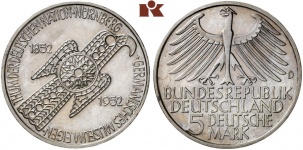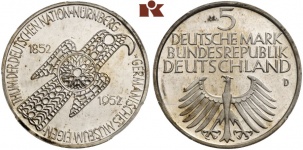Pattern of 5 DM “Germanisches Museum”
21. May 2015 08:00
As part of Auction 292, Lot 8133 contains a die of the reverse pattern of the first commemorative coin of the Federal Republic of Germany “Germanic Museum”. On the occasion of Auction 264, conducted on June 25, 2015, we did some research on the history of this pattern of which we offered a specimen at that auction.
In August 1952, the German National Museum in Nuremberg celebrated its 100th anniversary. The then Federal President Theodor Heuss, in his capacity as Chairman of the Administrative Board of the National Museum, thought that this jubilee would offer a splendid opportunity to show the public, both at home and abroad, that Germany had indeed changed. At the place where the Nazis used to hold their Nuremberg rallies, he celebrated German culture, and demanded in his programmatic opening speech that the city of Nuremberg ought to shake off its bad reputation, which originated in the recent past, and that its intellectual and its artistic life ought to express itself again.
The administration discussed of course supporting measures for this mega event. In a letter dating from July 3, 1952 – rather late, admittedly –, the Bavarian State Ministry of Education and Cultural Affairs pointed out “that the Federation should issue a commemorative coin on the occasion of the centennial, following the example of the world’s cultural states’ best practice. It would be not necessary that the coin would be issued on the day of the jubilee, as it would likewise attract attention, if it was issued in autumn 1952.”
The Ministry of Finance supported the suggestion. After all, it hoped for a major seignorage. Besides, the Minister of Finance, Dr Fritz Schäffer, member of the Christian Social Union in Bavaria, might have thought this to be a chance to promote a matter of his fellow party members. Hence, a letter was written, containing the following statement: “That is why the motion of the Bavarian State Ministry of Education and Cultural Affairs is being accepted. The total face value of all coins to be appropriately coined is estimated: based on current experience, it amounts to 1 million DM, that is to say 200,000 coins of 5 DM each. The coins are to be issued at market value. Their design is to be determined by the Federal Government.
Upon approval by the Central Council of the Bank of German States, it will be possible to coin 400 million DM, in the denomination of 5 DM, of which the Bavarian State Mint is going to produce 104 million DM. That sum is cut back by 1 million DM for the circulation coins and balanced by a minting contract in the same amount that will be awarded for the commemorative coins. By that, it is no longer necessary for the Central Council of the Bank of German States to be involved because the total contingent remains constant. The required metal (almost 2,300 kilograms of silver and copper) are available.
The competition for the commemorative coin’s design is not open to all artists but restricted, all four artists are winners of the previous public competition. The offered fee of 3,000 DM is kept reasonable.”
The decision of the Ministry of Finance was issued at the beginning of August so that the artists could then be invited to enter the competition. The date for the jury’s initial meeting had to be postponed a number of times because not every draft had been submitted in time. However, it was as early as October 9, 1952, that the draft of the Munich-based medalist Karl Roth was accepted, due to “the symbolic being concise and the formal being well-balanced and lucid”. It was a top-class jury. It consisted of the director of the German National Museum, the head of the Bavarian State Coin Collection as well as the head of the Bavarian Mint in Munich. The only thing they criticized was the side of the eagle which the artist was obliged to rework, therefore. Karl Roth complied and handed in a new draft which was then accepted unanimously.
What a pity that Theodor Heuss was shown the two drafts for approval. It was even a greater pity that the Federal President played the great patron of industrial design. He decided that the numeral was easier to read in the first variant than in the second and consequently overruled the jury’s decision. It goes without saying that the cabinet adopted the proposal of Mr Federal President in its meeting on December 16, 1952, and thus ignored nonchalantly both the expertise and the decision of the adjudicating panel. The jury of course protested but the media was informed and had already been supplied with the relevant photo material which rendered every further objection futile.
The artist likewise tried to intervene and advocated his revised draft. But researchers used to reject the idea of a trial strike of the dismissed draft, even though, as pointed out by Gerd Dethlefs in his ground-breaking article with the title “Die frühen Gedenkmünzemissionen der Bundesrepublik 1952 bis 1966”, the artist’s widow clearly recalls this trial strike being executed. The specimen now offered by Künker proves evidence that the artist indeed executed such a trial strike.
The reverse of the pattern that was not released, of which until now a plaster cast model was the only testimony, is markedly different from the actual coin. It shows the federal eagle and the inscription homogeneously distributed while in the accepted pattern the inscription is a bit unbalanced graphically and makes the eagle become a marginal figure. Since the alternative for the first German commemorative coin has finally shown up, everyone can form his own opinion about the taste of Federal President Theodor Heuss.
Back in 1953, the citizens of the Federal Republic were underwhelmed by the commemorative coin. After September 11 everybody could change it for 5 DM at the bank counters. But just a few collectors did. In 1953, 5 DM was much money. That was a month’s rent, on average. At the beginning of the Wirtschaftswunder, a family of four had an average gross income of 343 DM, with 20 DM at free disposal. No wonder, then, that many specimens of the ‘Germanic Museum’ made it into circulation eventually.
Today, things are different. Of all commemorative coins issued by the Federal Republic of Germany, the ‘Germanic Museum’ is the most expensive one. It is quite hard to get it in a perfect state of preservation. Yet when it does happen, the coin in question easily obtains a price considerably higher than 1,000 euros.

Pattern for the first commemorative coin of the FRG, ‘Germanisches Museum’.
Auction Künker 264 (June 25, 2015).
Estimate: 15,000 euros.

Commemorative coin ‘Germanisches Museum’, as executed.
Auction Künker 264 (June 25, 2015).
Estimate: 1,000 euros.


